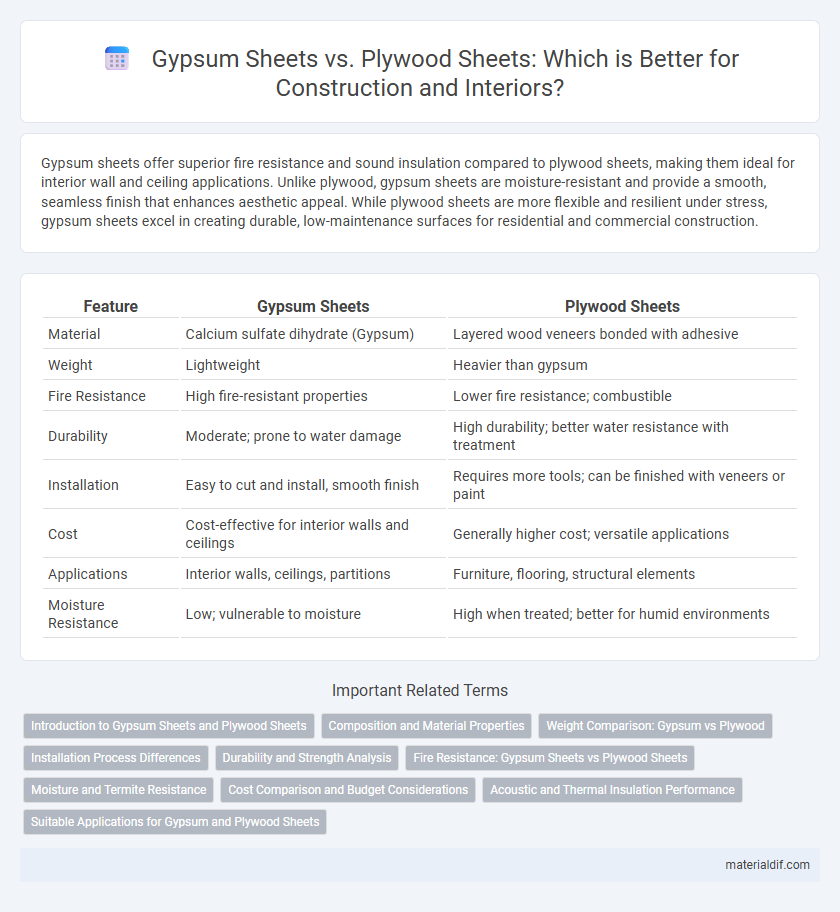Gypsum sheets offer superior fire resistance and sound insulation compared to plywood sheets, making them ideal for interior wall and ceiling applications. Unlike plywood, gypsum sheets are moisture-resistant and provide a smooth, seamless finish that enhances aesthetic appeal. While plywood sheets are more flexible and resilient under stress, gypsum sheets excel in creating durable, low-maintenance surfaces for residential and commercial construction.
Table of Comparison
| Feature | Gypsum Sheets | Plywood Sheets |
|---|---|---|
| Material | Calcium sulfate dihydrate (Gypsum) | Layered wood veneers bonded with adhesive |
| Weight | Lightweight | Heavier than gypsum |
| Fire Resistance | High fire-resistant properties | Lower fire resistance; combustible |
| Durability | Moderate; prone to water damage | High durability; better water resistance with treatment |
| Installation | Easy to cut and install, smooth finish | Requires more tools; can be finished with veneers or paint |
| Cost | Cost-effective for interior walls and ceilings | Generally higher cost; versatile applications |
| Applications | Interior walls, ceilings, partitions | Furniture, flooring, structural elements |
| Moisture Resistance | Low; vulnerable to moisture | High when treated; better for humid environments |
Introduction to Gypsum Sheets and Plywood Sheets
Gypsum sheets are lightweight, fire-resistant panels made from calcium sulfate dihydrate, commonly used for interior walls and ceilings due to their smooth finish and soundproofing qualities. Plywood sheets consist of thin layers of wood veneer glued together, prized for their strength, flexibility, and moisture resistance in construction and furniture applications. Comparing both, gypsum sheets offer better fire resistance and ease of installation, while plywood provides superior structural support and durability.
Composition and Material Properties
Gypsum sheets consist primarily of calcium sulfate dihydrate, offering excellent fire resistance and sound insulation due to their dense, mineral-based composition. Plywood sheets are made from thin layers of wood veneer bonded with adhesives, providing superior structural strength and flexibility but are more susceptible to moisture damage. The inorganic nature of gypsum sheets enhances their moisture resistance and fireproof qualities, while plywood's organic composition grants durability and load-bearing capacity in construction applications.
Weight Comparison: Gypsum vs Plywood
Gypsum sheets typically weigh between 8 to 15 kg per square meter, making them significantly heavier than plywood sheets, which generally weigh around 3 to 8 kg per square meter depending on thickness and wood type. The higher density of gypsum contributes to its weight but provides excellent fire resistance and sound insulation compared to lightweight plywood. For construction projects prioritizing weight reduction, plywood is preferred, whereas gypsum sheets are ideal for applications requiring robust fireproof and acoustic properties despite their heavier weight.
Installation Process Differences
Gypsum sheets offer a faster installation process due to their lighter weight and standardized dimensions, allowing for easy cutting and fitting with minimal tools. Plywood sheets require more labor-intensive handling because of their heavier weight and the need for precise measurements to avoid warping or splitting during installation. Gypsum sheets also benefit from integrated joint taping and finishing, which streamlines the process compared to the additional sealing and sanding often necessary with plywood.
Durability and Strength Analysis
Gypsum sheets offer superior fire resistance and moisture regulation but lack the tensile strength and impact resistance found in plywood sheets. Plywood sheets provide enhanced durability against physical stress due to their layered wood composition, making them ideal for load-bearing applications. Both materials require careful selection based on environmental exposure and structural demands to optimize longevity and performance.
Fire Resistance: Gypsum Sheets vs Plywood Sheets
Gypsum sheets offer superior fire resistance compared to plywood sheets due to their non-combustible composition and ability to release water vapor when exposed to heat, which helps slow fire spread. Plywood sheets, being composed of wood fibers and adhesives, are inherently combustible and can ignite more quickly under high temperatures. Fire-rated gypsum boards are commonly used in building construction to meet fire safety codes and provide enhanced protection in walls and ceilings.
Moisture and Termite Resistance
Gypsum sheets offer superior moisture resistance compared to plywood sheets, making them ideal for humid environments and bathrooms. Unlike plywood, gypsum sheets are inherently termite-resistant due to their non-organic composition, reducing the risk of pest damage. This makes gypsum sheets a durable and low-maintenance choice where moisture and termite exposure are concerns.
Cost Comparison and Budget Considerations
Gypsum sheets generally have a lower initial cost compared to plywood sheets, making them a budget-friendly option for interior walls and ceilings. While plywood sheets may have higher upfront expenses due to their durability and load-bearing capacity, gypsum sheets require less specialized labor, reducing overall installation costs. Budget considerations should weigh the long-term performance and maintenance costs, where gypsum sheets offer cost efficiency for non-structural applications.
Acoustic and Thermal Insulation Performance
Gypsum sheets offer superior acoustic insulation due to their dense and layered structure, effectively reducing sound transmission compared to plywood sheets. In terms of thermal insulation, gypsum provides better fire resistance and heat protection, making it ideal for maintaining indoor temperature stability. Plywood sheets, while structurally strong, lack the same level of sound dampening and thermal insulation properties found in gypsum materials.
Suitable Applications for Gypsum and Plywood Sheets
Gypsum sheets are ideal for interior wall linings, ceilings, and moisture-resistant areas due to their fire resistance and smooth finish, making them perfect for residential and commercial spaces. Plywood sheets, known for their strength and durability, suit structural applications, flooring, and furniture-making where load-bearing capabilities and impact resistance are essential. Selecting gypsum or plywood sheets hinges on the specific requirements of moisture exposure, fire safety, and mechanical strength in construction projects.
Gypsum sheets vs Plywood sheets Infographic

 materialdif.com
materialdif.com